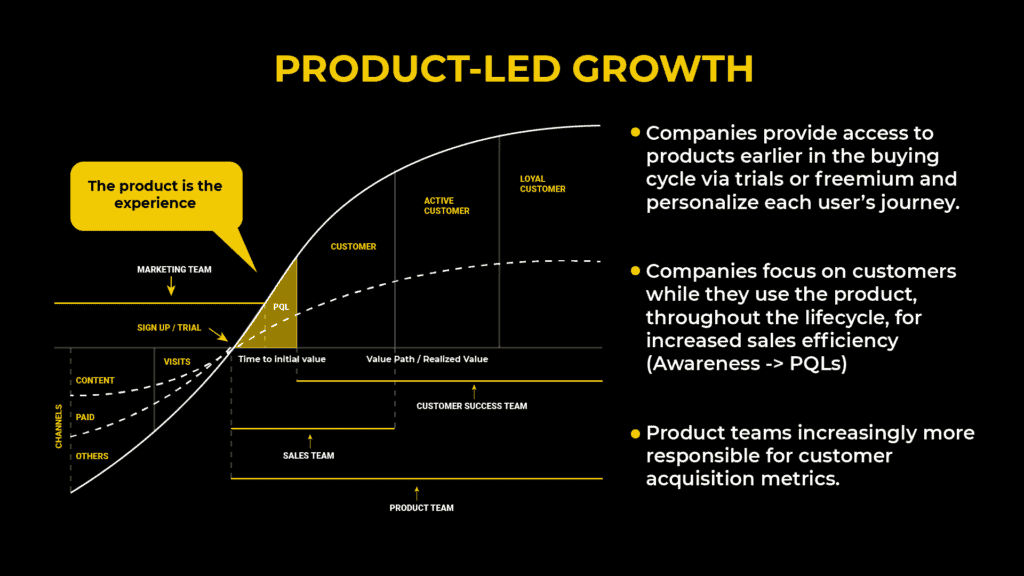Are you looking to launch a new software and drive success for your business? In today’s competitive market, it is more important than ever to find effective ways to differentiate your product and drive growth. One approach that has gained traction in recent years is product-led growth.
Product-led growth is a business strategy that focuses on using the product itself as the primary driver of growth. This approach is based on the idea that if the product is truly valuable and solves a real problem for users, it will be able to drive growth on its own without relying on traditional marketing and sales tactics.
There are many benefits to using product-led growth when launching a new software. For one, it allows you to focus on creating a truly valuable and differentiated product, rather than spending time and resources on marketing and sales efforts. Additionally, product-led growth can help to build trust and credibility with users, as they are able to try the product and see its value for themselves before committing to a purchase.
Of course, launching a new software using product-led growth is not without its challenges. One key consideration is ensuring that the product is truly valuable and solves a real problem for users. Additionally, it is important to have a clear plan for how the product will be distributed and how users will be able to discover and try it.
In this blog post, we will explore the concept of product-led growth in more detail and discuss some key considerations for launching a new software using this approach. By the end of this post, you will have a better understanding of how product-led growth can help your business succeed.
Is launching new software using product-led growth that simple?

Source: productled.com
It’s definitely not simple! It requires careful planning and execution and a deep understanding of your target market and its needs. Here are the key steps to follow:
1. Develop a clear understanding of your target market and its needs.
Before you start developing your software, it’s crucial to have a deep understanding of who your target market is and what their needs and pain points are. This will help you create a product that is tailored to their specific requirements and addresses their challenges. First, identify your target market. This should include factors such as their demographics, interests, and behaviors. Once you have identified your target market, conduct research to learn more about their needs, pain points, and preferences. This can include methods such as market research surveys, focus groups, and customer interviews. Next, analyze the data you have collected to identify patterns and trends. This will help you gain insights into your target market’s needs and preferences and inform your product development. Finally, develop personas that represent your target market. These personas should include detailed information about their needs, pain points, and preferences and can be used to guide product development. By following these steps, you can develop a clear understanding of your target market and their needs, which will inform the development of your product and help ensure its success.
2. Create a minimum viable product (MVP).
Once you have a clear understanding of your target market, the next step is to create a minimum viable product (MVP) that is simple and easy to use, but also provides value to the user. The MVP should be a stripped-down version of your software that includes only the core features and functionality. This will help you test the market and gather feedback from early adopters.
3. Use feedback to refine and improve the product.
After launching your MVP, it’s important to gather feedback from users and use that feedback to refine and improve the product. This will help you identify any issues or challenges with the product, and make necessary changes to make it more useful and effective for your target market.
4. Launch the product and focus on the user experience.
Once you have a refined and improved product, it’s time to launch it to the market. At this stage, it’s crucial to focus on providing an exceptional user experience. This means making the product easy to use and intuitive, and providing excellent customer support and service. This will help you retain and grow your user base, and ultimately drive growth for your business.
5. Continuously gather feedback and improve the product.
After launching your software, it’s important to continue gathering feedback from users and using that feedback to improve the product and add new features and functionality. This will help you stay ahead of the competition and maintain a strong position in the market.
In conclusion, using product led growth to launch a new software has many advantages. It allows you to create a high-quality product that is tailored to the needs of your target market, and provides value to the user. This, in turn, can help you retain and grow your user base, and ultimately drive success for your business.
Product led growth also puts the focus on the user experience, ensuring that your software is easy to use and intuitive. This can help improve customer satisfaction and loyalty, and set your business apart from the competition.
Additionally, using product led growth allows you to continuously gather feedback from users and use it to improve and evolve your product. This can help you stay ahead of the competition and maintain a strong position in the market.
Overall, using product led growth to launch a new software is an effective way to drive success for your business. It allows you to create a high-quality product that provides value to the user, and uses that product to drive growth for your business.